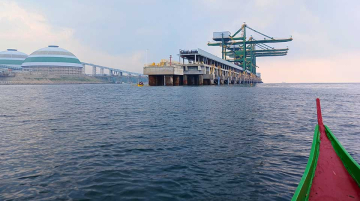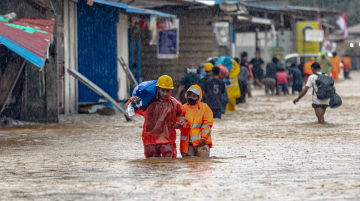
“It’s hard to earn [even] IDR 50,000 ($3) since the power plant is here,” said Dendi Arfani, a 26-year-old fisherman living in Teluk Sepang, a village in Indonesia’s central Bengkulu Province. “It’s not enough to cover our daily needs. Previously, in 2017, we could get a lot of fish. But since then, nothing.”

Arfani has been working as a fisherman for almost 11 years. Fishing is a traditional occupation for many communities in coastal towns across the archipelago, including Arfani’s village, which has relied on the ocean bounty for centuries.
Since the construction of the Teluk Sepang coal-fired power plant three years ago (in the first quarter of 2020), the usual fishing spots for Arfani and his peers have become dumping grounds for hot wastewater. This heat pollution causes fish in the area then to flee in search of cooler waters, putting them out of reach of most local fishermen and severely impacting their income.
The power plant – funded by Chinese state-owned energy giant PowerChina and local firm Intraco Penta, operated by Tenaga Listrik Bengkulu (TLB) – is part of Indonesian President Joko Widodo’s ambition to achieve 35,000 MW of electricity generation. As of last year, nearly 50% of the targeted capacity had already been commissioned.
This number will continue to increase, largely from industrial captive coal power plants financed by China, Fanny Tri Jambore, campaign manager of Indonesian environmental NGO WALHI told CGSP. China’s investment continues to grow, reaching $4.8 billion in 2020 and $5.18 billion in 2022, with 86% of the investment going into the construction of coal power plants, according to WALHI’s data.
This is despite China’s own pledge not to finance new coal power plants overseas. In 2021, Chinese President Xi Jinping announced the bold move in front of world leaders at the UN General Assembly in New York. And yet, the way Indonesians see it, new coal power plants backed by Beijing are still being built.
“They said… they are sticking to the existing contracts,” Jambore added.
“We can already see the suffering of the people living near the power plant, for example in Lahat, South Sumatra. Every day they breathe ash air, how long can our lungs survive?”
Jalaluddin, an elderly traditional fisherman in Teluk Sepang
At the same time, experts are doubting Indonesia’s own commitment to a clean energy transition. Last year, Indonesian President Jokowi launched a watered-down ban on new coal power plants – a ban with many exceptions and loopholes – which critics said was not enough.
“We are still pushing and asking the Indonesian government to stand by their commitment to the Paris Agreement,” researcher at NGO Auriga Nusantara Fattia Syafira said. With the half-hearted ban, “we know the government is still looking for a way to build a power plant even in 2025 or 2030 using their derivative products,” Syafira added.
China is recorded to have investments in fourteen operating coal power plants across Indonesia, according to Auriga’s data, and is estimated to be involved in dozens of new coal projects. Across Indonesia, new coal power plants with a combined capacity of nearly 15,000 MW will be constructed until 2030, despite the country’s pledge to switch to renewable energy. In Sumatra alone, fourteen new coal projects with a capacity of 4,000 MW are under development, including in Aceh and Jambi.
But even now, local communities are already facing devastation. According to data from Pulau Baai port, the number of fish production has been declining since 2019, from 8.6 million tonnes that year to 7.5 million tonnes in 2020, before sharply falling to 4.2 million tonnes in 2021 and again to 2.4 million tonnes in 2022.

Nearly all Teluk Sepang residents had been fishermen who were operating about 120 boats in Pulau Baai Port. Today, only about 20 vessels are still active, as most were bankrupted, according to local fishermen CGSP talked to. As fish are migrating elsewhere, many traditional fishermen in Teluk Sepang are forced to find other jobs.
“Sometimes we work as construction workers, or removing tarps of coal trucks, whatever we do to earn money,” Arfani, the fisherman, added.
Health and Safety At Risk
Apart from losing their livelihoods, local communities must also deal with health and safety risks from the power plant. Dust from the facility has made children’s skin develop rash and itches, and there is always the risk of electronic damage from the overhead lines.
“We can already see the suffering of the people living near the power plant, for example in Lahat, South Sumatra. Every day they breathe ash air, how long can our lungs survive?” Jalaluddin, an elderly traditional fisherman in Teluk Sepang, told CGSP.
The power plant has also been dumping fly and bottom ash in an open area on Panjang Beach, and its hot wastewater dump is killing turtles, according to advocacy organization Kanopi Hijau Indonesia. Nearly 30 turtles were found dead near the dump spot. In addition, Kanopi records showed that the power plant had dumped hazardous waste, such as used oil, in the agricultural area of Teluk Sepang.
“Power Plant Teluk Sepang continues to commit violations,” said Hosani Hutapea, Campaign Manager for Green Canopy Mining Indonesia. “We urge the Minister of Environment and Forestry, Siti Nurbaya, to take action against the power plant, which has repeatedly violated regulations, by revoking or suspending its environmental permit.”
PowerChina and Intraco Penta did not respond to CGSP’s requests for comment on the environmental fallout of the plant.
Betty Herlina is a freelance journalist based in Bengkulu, Indonesia.





